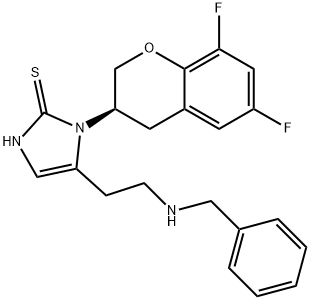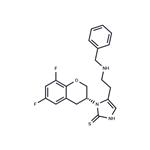Zamicastat (10, 30 and 100 mg/kg/day; oral bolus, 7 days) is tested acutely against salt-induced hypertension in the Dahl SS rat. Zamicastat produces a dose-dependent decrease in blood pressure. 24 h after Zamicastat administration mean systolic blood pressure (SBP) decrease is -12.6±4.1 mm Hg (P=0.0284), -15.2±2.7 mm Hg (P=0.0026) and -19.0±3.7 mm Hg (P=0.0036) for the 10, 30, and 100 mg/kg body weight dose, respectively. Zamicastat administration also produces a significant 24-h average decrease in diastolic blood pressure (DBP) of - 14.6±3.4 mm Hg (P=0.0073) with 10 mg/kg body weight dose, -13.0±4.5 mm Hg (P=0.0347) with 30 mg/kg body weight dose and -15.0±3.1 mm Hg (P=0.0046) with 100 mg/kg body weight dose. Zamicastat administration leads to a decrease in the 24h post-dose mean arterial pressure (MAP) of -13.4±3.8 mm Hg (P=0.0162), -14.0±3.5 mm Hg (P=0.0101) and -20.6±3.7 mm Hg (P=0.0026) for the 10, 30, and 100 mg/kg body weight dose, respectively. There is a small, but significant, effect of Zamicastat on the 24-h mean heart rate (HR) post-dose for all tested doses (10 mg/kg: -19.1±3.2 beats/min, P=0.0019; 30 mg/kg: -13.0±4.5 beats/min, P=0.0347; 100 mg/kg: -21.6±6.6 beats/min, P=0.0235)[2].
| Animal Model: | Six-week-old male inbred male Dahl SS rats[2] |
| Dosage: | 10, 30, or 100 mg/kg; 4 mL/kg |
| Administration: | Oral bolus, daily, seven days |
| Result: | Treatment produced a dose-dependent decrease in blood pressure. Twenty four hours after administration mean SBP decrease was -12.6±4.1 mm Hg (P=0.0284), -15.2±2.7 mm Hg (P=0.0026) and -19.0±3.7 mm Hg (P=0.0036) for the 10, 30, and 100 mg/kg body weight dose, respectively. |
| Animal Model: | ten-week-old male Wistar Han rats[2] |
| Dosage: | 30 mg/kg/day |
| Administration: | in animal feedings (mixed in meal rodent food) everyday |
| Result: | lead to a significant 51% decrease in noradrenaline levels excreted in urine |



